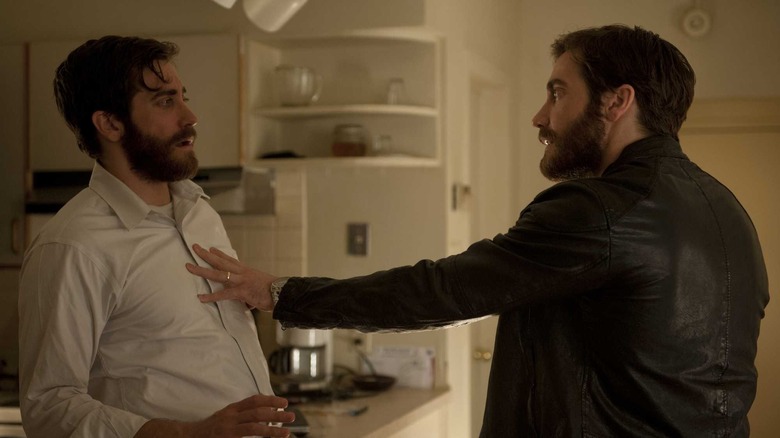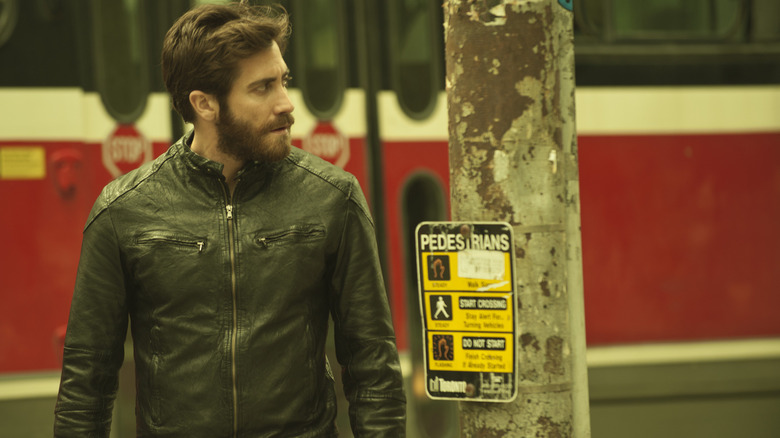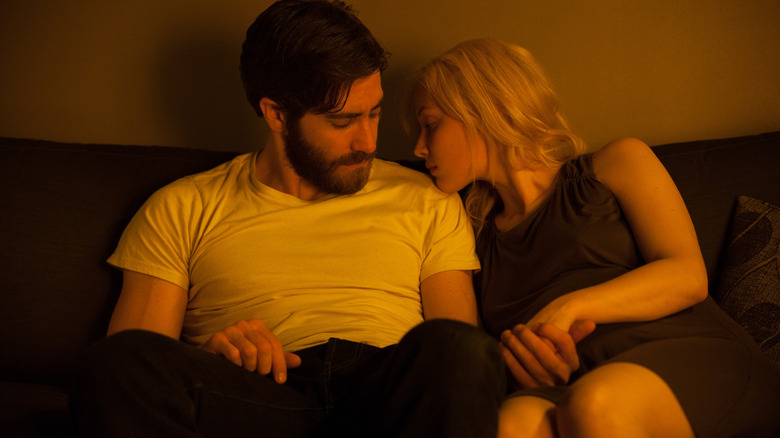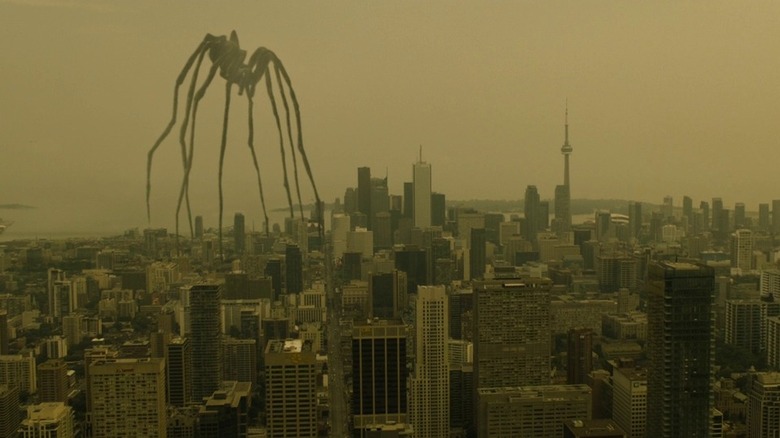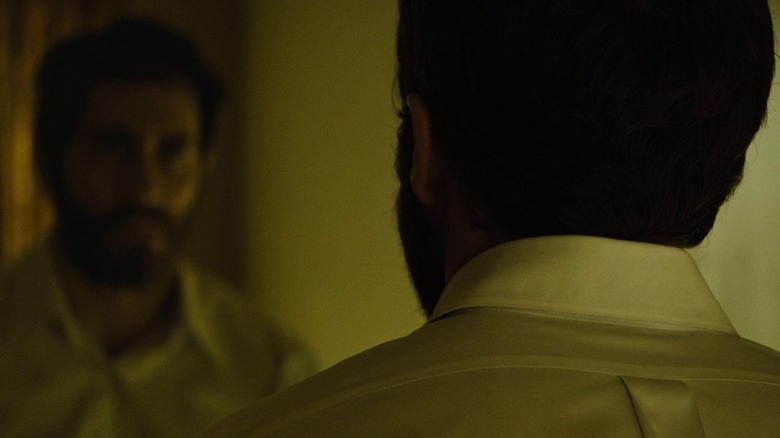Enemy Ending Explained: Trapped In A Web Of One's Own Making
In the span of less than a decade, Denis Villeneuve has managed to ascend the ranks of recognizable, name-brand writer/directors to become one of the most reliable, challenging, and consistent visionary filmmakers around ... but it's safe to say he wouldn't have made it this far if it weren't for a much lesser-known thriller that helped put him on the map. 2013's "Enemy," based on José Saramago's novel "The Double," has incited all sorts of fascinating discussions and analysis across film circles, mostly for its utterly confounding imagery, difficult and disturbing themes, and perhaps one of the most terrifying and controversial final shots of any movie made this century. Viewers who've seen "Enemy" for the first time typically come away with strong opinions about the very last scene, which we'll get to in a moment, but every second preceding that chilling conclusion demands just as much attention and focus.
The psychological neo-noir features a straightforward enough premise at first glance, yet Villeneuve imbues everything — even the very heart of the city of Toronto, which he glazes over in a sickly yellow sheen — with details that both overtly and subconsciously creep under one's skin. True to form, the film follows an unremarkable college professor named Adam and a headstrong local actor named Anthony (both played by Jake Gyllenhaal) who cross paths, realize they resemble perfectly identical physical doppelgängers of one another (down to an old scar or birthmark!) despite living out completely different lives, and proceed to obsess over one another's circumstances. It's not much of a spoiler to say that things take a disturbingly dark but inevitable turn by the end.
For all the talk of ominous foreshadowing, provocative symbolism, and recurring motifs of spiders, however, the key to understanding "Enemy" remains deceptively simple: an open mind.
What you need to remember about the plot of Enemy
The off-putting nature of "Enemy" rears its head almost immediately. In some nondescript, underground nightclub of sorts, a man quietly observes an exotic dancer putting on a show. This otherwise erotic performance, however, only builds to a thoroughly startling climax: the woman comes inches away from crushing an unexplained tarantula beneath her heels. This skin-crawling start sets the tone for the rest of the story to come, when we're introduced to history professor Adam Bell living out his days in an unending cycle that has clearly been wearing on him for some time. When he isn't delivering lectures on totalitarianism in front of a sparse crowd of students, he's mindlessly winding down at home ... until, one day, he watches a movie at the recommendation of a colleague and seems to spot his exact spitting image in the background of a shot. His curiosity aroused, Adam falls down a rabbit hole that ultimately leads to him making contact with this mysterious "twin" — a local actor named Anthony Claire.
Once Adam's increasingly intrusive actions puts himself on Anthony's radar, Anthony returns the favor and digs deeper into this disquieted stranger whom he initially mistook for a threatening fan. Anthony's pregnant wife Helen (Sarah Gadon), suspicious that Anthony is pulling an elaborate prank, enacts her own investigation and tracks down Adam at his college, even starting a conversation with this man who looks exactly like her husband ... only to realize that he has absolutely no idea who she is. Both men finally agree to meet the other in person, which accomplishes nothing except to freak them out even more. At this point, the malicious Anthony begins to scheme to sleep with Adam's girlfriend Mary (Mélanie Laurent), exacerbating tensions even more.
What happened at the end of Enemy
Unsurprisingly, this antagonistic dynamic between two identical men who couldn't possibly have more opposite personalities builds to a disastrous crescendo. What once began as an innocent and seemingly harmless inquiry soon turns into a sickening power play, as both male egos ultimately succumb to the temptation of seducing the other's romantic partner. Mary, Adam's girlfriend, remains unaware that anything is amiss when Anthony takes her on a romantic getaway to a nearby hotel ... that is, until she spots the telltale mark on his finger where a wedding band usually resides and panics. As for Helen, completely fed up with Anthony's antics, she instantly sees through Adam's (poor) attempts to impersonate his double, part of a half-hearted ploy to get back at him through her. She doesn't care, however, freely admitting that she prefers his company instead.
The jig is up, however, once Mary grasps the depths of this deception. Angrily demanding to be driven from their hotel room and back to her home, she and Anthony get into a heated argument and end up in what certainly appears to be a fatal car accident. As for Adam, he attempts to continue the ruse that he's Anthony and gets his hands on an exclusive key to the sex club that we see Adam attending at the beginning of the film. Intrigued by the invite, he surreptitiously announces to Helen that he's vaguely planning to "go out" that night. When she doesn't respond, Adam goes in search of her in her bedroom. What he finds is a nightmare turned reality: instead of Helen, he encounters a giant spider cowering in terror at his presence. While treated as an unbelievably frightening jump-scare for audiences, Adam simply sighs in resignation as the film cuts to credits.
What the end of Enemy means
For anyone who read this far hoping for some magical, one-size-fits-all answer to everything that Villeneuve is trying to convey with this movie, I'm afraid that's the most counterintuitive approach to analyzing a story as enigmatic as this one. While the cold, calculating horror of "Enemy" certainly feels of a piece with the director's more audience-friendly efforts, this film plays similarly to movies like Alex Garland's "Annihilation" — while they're both adaptations of texts, they take a much looser and more dreamlike approach to communicating their respective themes.
First and foremost, it helps to break free of the notion that everything is depicted literally and logically in "Enemy." Another possible interpretation for Adam and Anthony's various interactions could be that they're both opposing extensions of the same man's personality as he undergoes a profound midlife crisis. This doesn't necessarily have to resemble a Tyler Durden situation, mind you, but merely that they're manifestations of all the same character flaws and mindsets that plague normal individuals. Anthony may symbolize the virility and recklessness of youth, chasing women (as his own mother accuses him of at one point in the film) and embracing his own selfish immaturity. Adam, on the other hand, represents the hopelessness of aging, tacitly looking for an escape from his mundane existence.
But how does this dovetail with all those spiders? Notice the shared feeling that links both Adam and Anthony together: a sense of entrapment. We repeatedly see spiders pop up either in the club or as a giant kaiju let loose on Toronto. The final haunting image, which explicitly draws a connection between itself and Helen, suggests Adam/Anthony's feelings towards women in general. Like a spider building a web, they feel suffocated by the life they themselves chose.
What has the director of Enemy said about the ending?
Ultimately, "Enemy" leaves its central mystery unexplained, and the film is infinitely better for it. Much like Christopher Nolan's "Inception," any concrete explanation of the film's ending would only water down its ambitions. And, similar to Nolan's stance of never telling audiences what to think or how to feel, Denis Villeneuve likewise hesitates to offer up any cut-and-dry answer to what he purposefully left as an ambiguous journey for viewers to take. That said, the director did make the press rounds just before the film's limited theatrical release back in 2014, talking to The Hollywood Reporter about the questions surrounding both Adam and Anthony and one possible interpretation of their perplexing predicament:
"You don't know if they are two in reality, or maybe from a subconscious point of view, there's just one. It's maybe two sides of the same persona [...] or a fantastic event where you see another [self]."
That explains why he recruited an actor as talented as Gyllenhaal, who brought both personas to life with immaculate attention to detail, but he's more reticent to give away the game regarding the final shot. "For me, the final image has a precise meaning, but I like to let the audience free to find it by themselves." As disappointing as that answer may be, however, Villeneuve does offer up this one tidbit. To him, the film boils down to one overarching idea: "How can we evolve and not repeat the same mistakes that we are doing over and over again?"
To give Villeneuve the final word, "That's why the movie is constructed like a spiral. That's why it's a challenge for the audience, it's an enigma, but I hope that the audience will have fun trying to solve this enigma."
